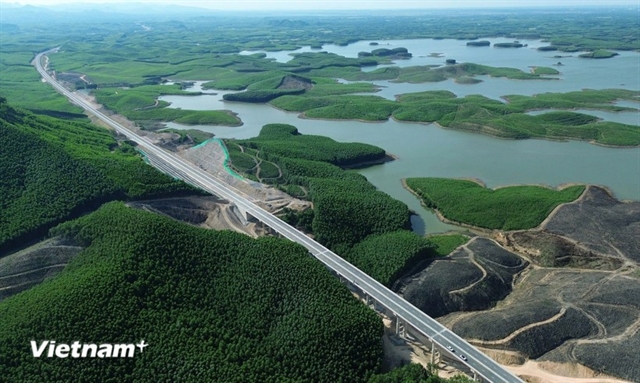 Society
Society


|
| A traffic jam at Kim Mã-Đào Tấn intersection in Hà Nội on December 15. Việt Nam performs well in terms of forest coverage and response to disasters, but is among the bottom third of countries in terms of carbon emissions per unit of GDP, according to 2020 Human Development Report by UNDP. — VNA/VNS Photo Thành Đạt |
HÀ NỘI — Việt Nam has joined the ranks of countries with high human development, but this remarkable progress has been accompanied with relatively high pressure on the planet.
These are among the key findings of the 2020 Human Development Report: “The next frontier – Human Development and the Anthropocene,” released in Việt Nam on Wednesday by the United Nations Development Programme (UNDP) in cooperation with the Ministry of Planning and Investment.
The Anthropocene — or The Age of Humans — refers to the new geological age we are living in where for the first time instead of the planet shaping humans, humans are shaping the planet.
According to the report, the COVID-19 pandemic is the latest crisis facing the world, but unless humans release their grip on nature, it won’t be the last. Therefore, the report introduces a new experimental index on human progress that takes into account countries’ carbon dioxide emissions and material footprint - planetary-pressures adjusted HDI (PHDI).
Việt Nam performs well in terms of forest coverage and response to disasters, but is among the bottom third of countries in terms of carbon emissions per unit of GDP, land degradation (31 per cent of the total land area), and use of fertiliser nutrients per hectare of cropland, it said.
The next frontier for human development will require working with and not against nature, while transforming social norms, values, and government and financial incentives, the report argues. Easing planetary pressures in a way that enables all people to flourish in this new age requires dismantling the gross imbalances of power and opportunity that stand in the way of transformation.
Caitlin Wiesen, UNDP Vietnam Resident Representative, said Viet Nam loses 5.7 per cent of its HDI, due to carbon dioxide emissions and material consumption per capita.
“So the idea with this planetary HDI is to raise attention as well, that we need to look at a balance, and we need to read harmonise that this extraordinary human development on the one hand needs to be balanced with the environment,” she told Viet Nam News.
“Viet Nam’s High Human Development is a remarkable achievement and also creates opportunities for greater and more rapid progress in the coming development period.
“The country is at a critical juncture as it designs its next Socio-Economic Development Strategy, with decisions made today determining whether it will continue on it current path of growth and low inequality, and whether it can simultaneously shift to reducing pressure on the planet to enhance the harmony of the people and the environment,” said Wiesen.
Wiesen said Việt Nam performed well in terms of gender equality. Việt Nam is in the highest among five groups according to the Gender Development Index (with a value of 0.997), and Viet Nam ranks 65 out of 162 countries on the Gender Inequality Index. Particularly commendable is the share of seats in parliament held by women (27 per cent) which places Viet Nam among the top third of countries globally.
However, she said, there is room for improvement.
Việt Nam ranks among the bottom third of countries globally in terms of sex ratio at birth (1.12), violence against women by intimate partners (34.4 per cent) and women with accounts in financial institutions or with mobile money service provider (30.4 per cent).
Regarding the quality of human development, Việt Nam is among the top third of countries in terms of lost healthy years as a percentage of expectancy (11.7 per cent), and the number of hospital beds (32 beds/100,000 people). All primary school teachers are trained, rural electrification covers 100% of the population and the unemployment rate is low.
However, Việt Nam is within the bottom third countries globally in terms of vulnerable employment (54.1 per cent) because of the large share of the labour force dependent on self-employment in household businesses. But household businesses are not registered. The UNDP is trying to look at a way to support the government, so that these groups can be captured and registration can be made easy when there are catastrophic incidents like COVID-19.
Trần Quốc Phương, Deputy Minister of the Ministry of Planning and Investment, said he was glad to see that Việt Nam’s HDI value for 2019 is 0.704, putting the country in the high human development category and positioning it at 117 out of 189 countries and territories.
Notably, Việt Nam’s loss of income due to inequality is 19.1 per cent and its GINI coefficient at 35.7 per cent are among the lowest in the East Asia and Pacific region.
“This is not an achievement any country with low average income can reach.
“Việt Nam is one of the countries most affected by climate change. With the additional use of this indicator, the country will have a basis in promulgating and implementing appropriate policies to promptly respond to the issue of environmental pollution and climate change,” he said.
Although the country’s emissions were not high, once it joined a group with a high level of human development, Việt Nam would also acknowledge its responsibility to reduce pressure on the planet, Phương said.
He also said the goal of sustainable development has been included in the 10-year socio-economic development strategy for 2021-2030 and socio-economic development plan 2021-2025 which are about to be passed in 2021, ensuring benefits for all. — VNS




